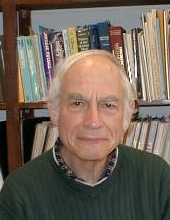
It is with great sorrow that we report the passing of our long-time colleague and friend, George Rawitscher on March 10, 2018, after a brief illness and just having passed his 90th birthday, which was celebrated with a cake at a meeting of the UConn Physics Department. George was born in 1928 in Germany, where his fa-ther was a distinguished Professor of Botany at The University of Freiburg. In 1934 his father, Felix Rawitscher who was Jewish, brought his family which in-cluded George’s mother, Charlotte Oberlander, his sister Erika, and George from Germany to Brazil to escape the Nazis. In Brazil, Felix established and chaired the Botany Department, which still bears his name, at the University of Sao Paulo.
George grew up in Sao Paulo, where he learned fluent Portuguese. From an early age he knew he wanted to be a physicist, and taught himself quantum mechanics from a book during high school. He graduated in physics and mathematics from the University of Sao Paulo in 1949, and he served as an Instructor at the Brazilian Center for Physical Research in Rio de Janiero for two years, receiving a Brazilian National Research Council Fellowship. While he was in the Center for Physical Research at Rio, he worked under Richard Feynman who was a visiting professor at the same institute. He told his grandson Nicholas that Feynman had made a big mark on his life, inspiring his approach to physics, and observing that he had the potential to become a “real” physicist, which he remained until the end of his life.
Following his time in Rio, George went to Stanford University as a graduate student in theoretical nuclear physics and mathematics. He received his Ph.D. in 1956, for a study of Fierz-Pauli spin 3/2 particles and the anomalous magnetic moment of the muon under Profs. Leonard Schiff and D.R. Yennie. His first paper had to do with the effect of the finite size of the nucleus on muon pair production by gamma rays.
While at Stanford, George met and later married Mary Adams, a fellow Stanford student, and they proudly raised two sons, Peter and Henry. Mary, a biochemist, died in 1980. In his later years, George was again happily married to Joyce Rawitscher in 2009, who passed away in 2016. Following his graduate work, George became an Instructor at the Physics Nuclear Structure Center (University of Rochester) for two years and then joined the Physics Department at Yale as Instructor, doing research in collaboration with Prof. Gregory Breit. He remained at Yale as Assistant Prof. of Physics until 1964. He joined the Physics Department at the University of Connecticut in Storrs as an Associate Professor and then became Professor of Physics from 1972. He retired in 2009 but remained at UConn as an emeritus Research Professor until days before his death, continuing to do active research in nuclear physics, computational physics and ultracold atomic collision physics until his final days.
Prof. Rawitscher received several prestigious academic honors including one of the early Research Fellowship awards from the Alexander von Humboldt Foundation (Germany) in 1964 and became a Fellow of the American Physical Society, nomi-nated by the Division of Nuclear Physics in 2016. During his tenure at the University of Connecticut, he took academic leaves at the Max Planck Institut fur Kernphysik in Heidelberg (1964-1966), the Laboratory for Nuclear Science at MIT (1972), as guest professor at the University of Surrey, England 1973, the University of Maryland (1987-1988) and served on the Board of Directors of Bates Users Theory Group at MIT (1982-1985) and the Executive Committee of the American Physical Society topical group on Few Body Systems and Multi-Particle Dynamics (1993-1995). He gave a number of invited presentations in nuclear theory at conferences, published approximately 88 refereed papers and numerous conference proceedings. His principal research interests involved scattering problems using non-local opti-cal models of nuclear processes, coupled-channel reaction mechanisms for nuclear break-up such as the (e,e’p) reaction, and virtual nuclear excitations. Recently he emphasized development of numerical methods such as Galerkin and spectral expansions for solving integral equations. He has applied some of these techniques to studies of ultracold atomic collisions as well as nuclear reactions. His most recent refereed papers (2015-2017) concerned “Revival of the Phase-Amplitude description of a Quantum-Mechanical wave function.”
Professor Rawitscher was an engaged and untiring participant both in his Department and in the general community up to the last moments of his life. He promoted public awareness and activism on ameliorating the effects of global climate change and he and his wife Joyce have been active in the peace movement. He was a member of the Storrs, CT Quaker Meeting. He was also active in community service in the Storrs area, for example serving on the Town of Mansfield Sustainability Committee. Recently he has been working on a nearly-finished book summarizing his lifelong expertise in numerical computational physics, under contract with Springer, with two younger colleagues from Brazil. George was a dedicated and effective undergraduate teacher and empathetic mentor to a large number of graduate students, colleagues and collaborators. George was a central member of the department for more than 50 years, and has earned a special place in our hearts forever. His inspiring presence and example will be very much missed at the University, amongst his family, friends and the community, and it was a great loss to see him go.